Comprehensive Risk Management Report: ERRY Program in Yemen
VerifiedAdded on 2021/05/31
|24
|4923
|123
Report
AI Summary
This report provides a comprehensive risk management analysis of the "Enhance Rural Resilience in Yemen (ERRY)" program. It begins with an introduction to the program's background, highlighting the challenges faced by the Yemeni people due to war and economic instability. The report then delves into the identification of various risks associated with the ERRY program, categorizing them into political, security, financial, operational, and social risks. These risks are evaluated based on their likelihood and severity, leading to a risk ranking. Subsequently, the report outlines mitigation strategies and a contingency plan, emphasizing conflict management, training, and knowledge management. Finally, the report emphasizes the importance of monitoring, evaluation, and reporting to ensure the successful implementation of the ERRY program, aiming to improve the livelihood and social cohesion of rural communities in Yemen. The report is structured to provide a clear understanding of the risks and potential solutions to ensure the project's success.
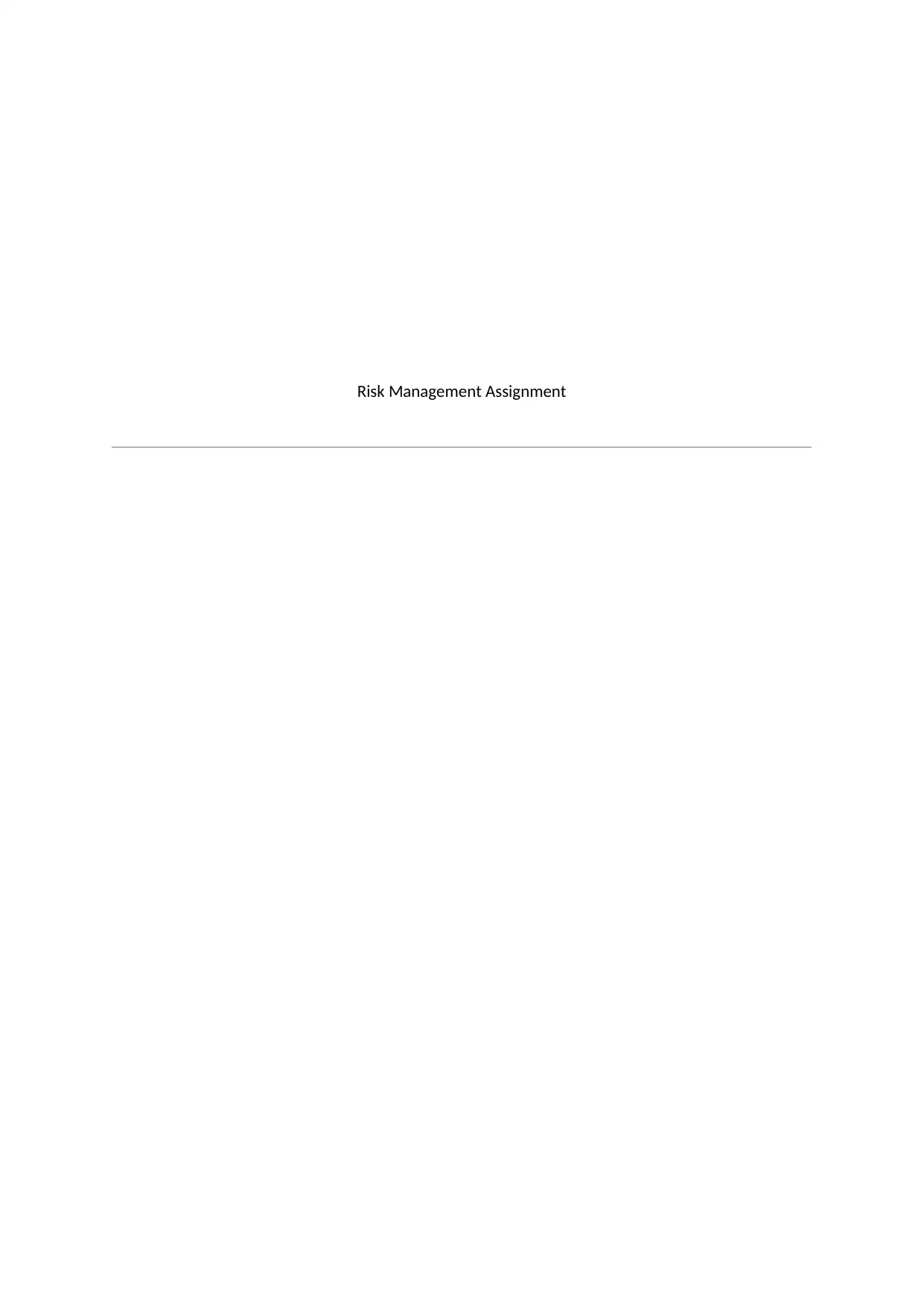
Risk Management Assignment
Paraphrase This Document
Need a fresh take? Get an instant paraphrase of this document with our AI Paraphraser
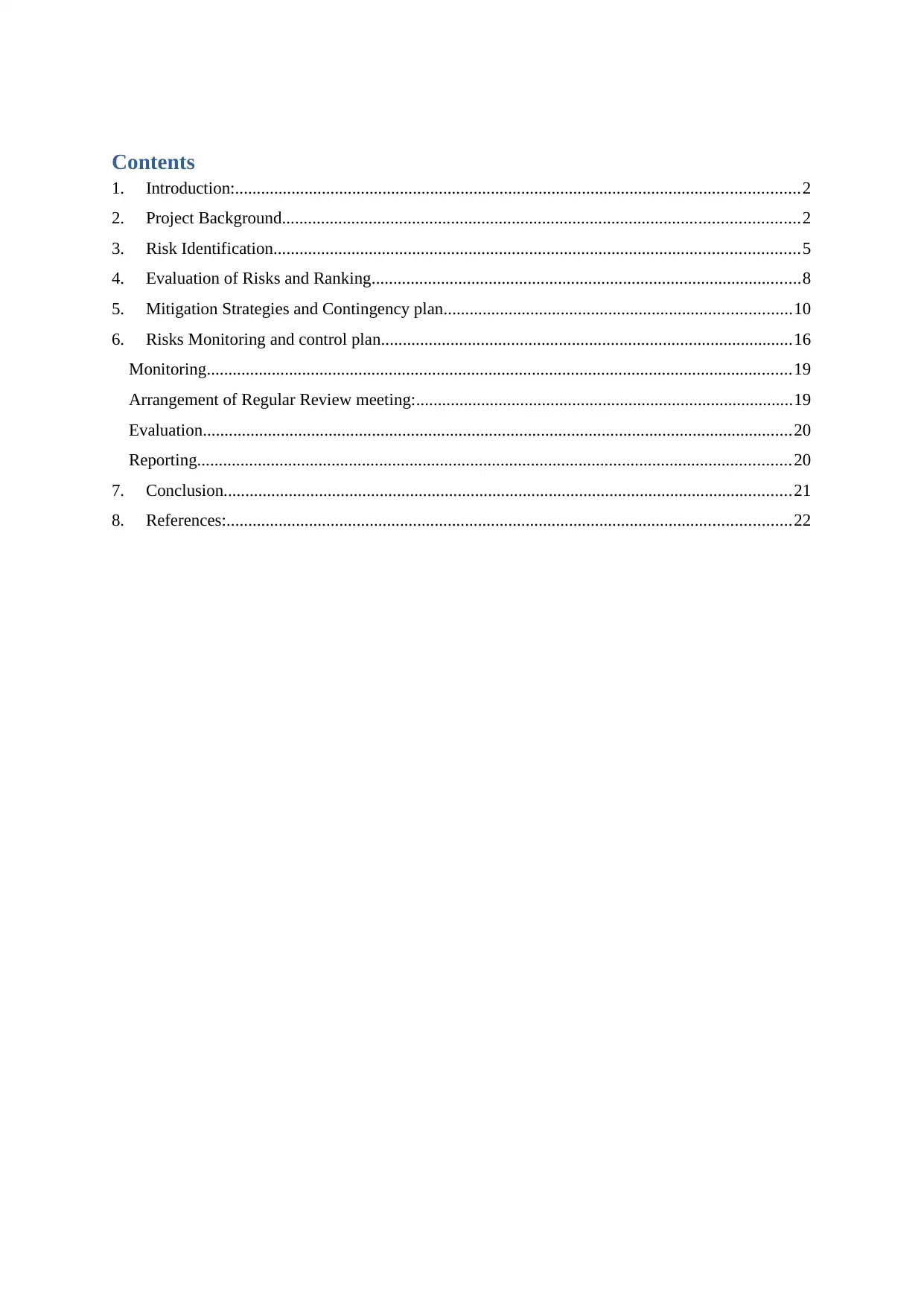
Contents
1. Introduction:..................................................................................................................................2
2. Project Background.......................................................................................................................2
3. Risk Identification.........................................................................................................................5
4. Evaluation of Risks and Ranking...................................................................................................8
5. Mitigation Strategies and Contingency plan................................................................................10
6. Risks Monitoring and control plan...............................................................................................16
Monitoring.......................................................................................................................................19
Arrangement of Regular Review meeting:.......................................................................................19
Evaluation........................................................................................................................................20
Reporting.........................................................................................................................................20
7. Conclusion...................................................................................................................................21
8. References:..................................................................................................................................22
1. Introduction:..................................................................................................................................2
2. Project Background.......................................................................................................................2
3. Risk Identification.........................................................................................................................5
4. Evaluation of Risks and Ranking...................................................................................................8
5. Mitigation Strategies and Contingency plan................................................................................10
6. Risks Monitoring and control plan...............................................................................................16
Monitoring.......................................................................................................................................19
Arrangement of Regular Review meeting:.......................................................................................19
Evaluation........................................................................................................................................20
Reporting.........................................................................................................................................20
7. Conclusion...................................................................................................................................21
8. References:..................................................................................................................................22
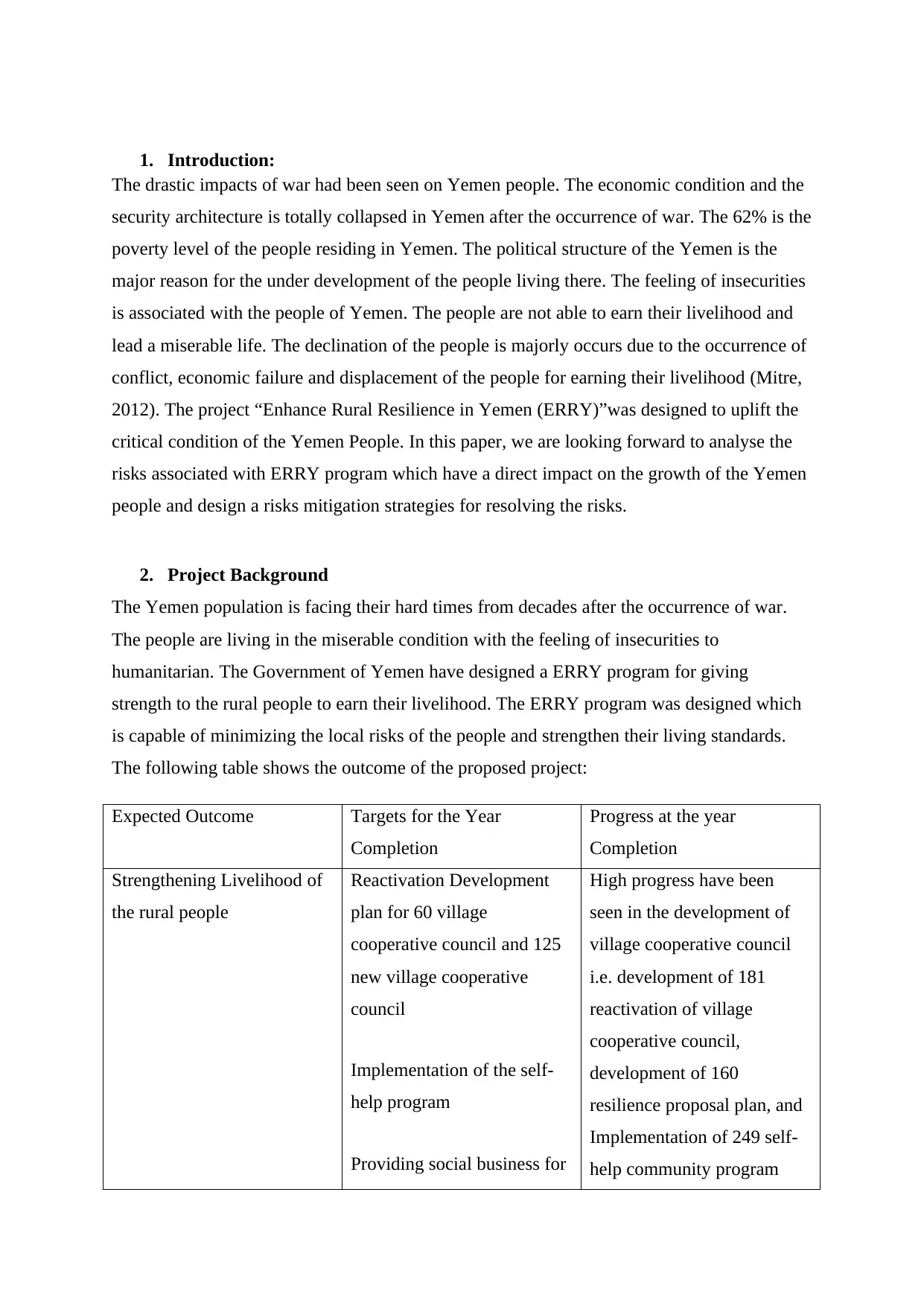
1. Introduction:
The drastic impacts of war had been seen on Yemen people. The economic condition and the
security architecture is totally collapsed in Yemen after the occurrence of war. The 62% is the
poverty level of the people residing in Yemen. The political structure of the Yemen is the
major reason for the under development of the people living there. The feeling of insecurities
is associated with the people of Yemen. The people are not able to earn their livelihood and
lead a miserable life. The declination of the people is majorly occurs due to the occurrence of
conflict, economic failure and displacement of the people for earning their livelihood (Mitre,
2012). The project “Enhance Rural Resilience in Yemen (ERRY)”was designed to uplift the
critical condition of the Yemen People. In this paper, we are looking forward to analyse the
risks associated with ERRY program which have a direct impact on the growth of the Yemen
people and design a risks mitigation strategies for resolving the risks.
2. Project Background
The Yemen population is facing their hard times from decades after the occurrence of war.
The people are living in the miserable condition with the feeling of insecurities to
humanitarian. The Government of Yemen have designed a ERRY program for giving
strength to the rural people to earn their livelihood. The ERRY program was designed which
is capable of minimizing the local risks of the people and strengthen their living standards.
The following table shows the outcome of the proposed project:
Expected Outcome Targets for the Year
Completion
Progress at the year
Completion
Strengthening Livelihood of
the rural people
Reactivation Development
plan for 60 village
cooperative council and 125
new village cooperative
council
Implementation of the self-
help program
Providing social business for
High progress have been
seen in the development of
village cooperative council
i.e. development of 181
reactivation of village
cooperative council,
development of 160
resilience proposal plan, and
Implementation of 249 self-
help community program
The drastic impacts of war had been seen on Yemen people. The economic condition and the
security architecture is totally collapsed in Yemen after the occurrence of war. The 62% is the
poverty level of the people residing in Yemen. The political structure of the Yemen is the
major reason for the under development of the people living there. The feeling of insecurities
is associated with the people of Yemen. The people are not able to earn their livelihood and
lead a miserable life. The declination of the people is majorly occurs due to the occurrence of
conflict, economic failure and displacement of the people for earning their livelihood (Mitre,
2012). The project “Enhance Rural Resilience in Yemen (ERRY)”was designed to uplift the
critical condition of the Yemen People. In this paper, we are looking forward to analyse the
risks associated with ERRY program which have a direct impact on the growth of the Yemen
people and design a risks mitigation strategies for resolving the risks.
2. Project Background
The Yemen population is facing their hard times from decades after the occurrence of war.
The people are living in the miserable condition with the feeling of insecurities to
humanitarian. The Government of Yemen have designed a ERRY program for giving
strength to the rural people to earn their livelihood. The ERRY program was designed which
is capable of minimizing the local risks of the people and strengthen their living standards.
The following table shows the outcome of the proposed project:
Expected Outcome Targets for the Year
Completion
Progress at the year
Completion
Strengthening Livelihood of
the rural people
Reactivation Development
plan for 60 village
cooperative council and 125
new village cooperative
council
Implementation of the self-
help program
Providing social business for
High progress have been
seen in the development of
village cooperative council
i.e. development of 181
reactivation of village
cooperative council,
development of 160
resilience proposal plan, and
Implementation of 249 self-
help community program
⊘ This is a preview!⊘
Do you want full access?
Subscribe today to unlock all pages.

Trusted by 1+ million students worldwide
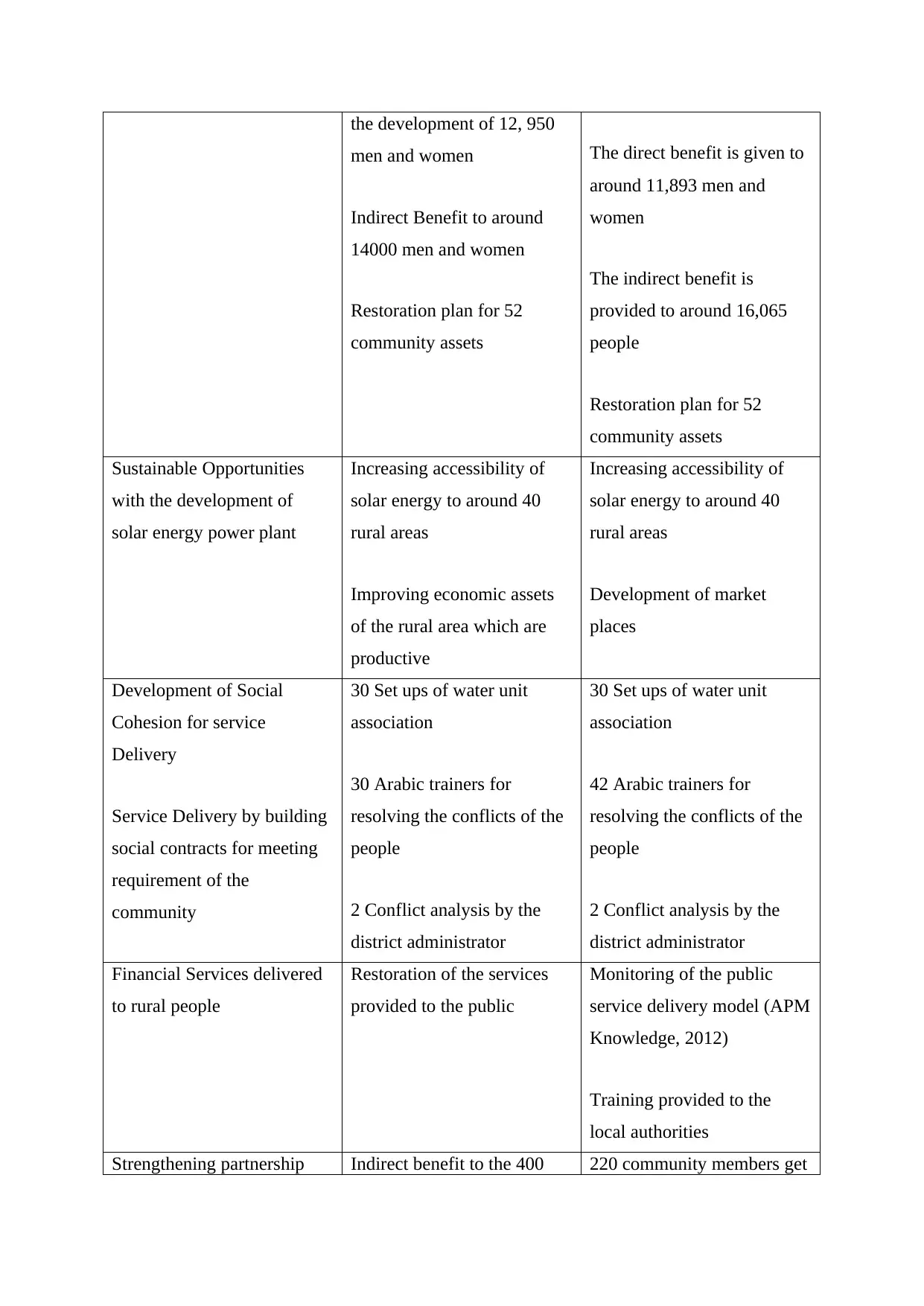
the development of 12, 950
men and women
Indirect Benefit to around
14000 men and women
Restoration plan for 52
community assets
The direct benefit is given to
around 11,893 men and
women
The indirect benefit is
provided to around 16,065
people
Restoration plan for 52
community assets
Sustainable Opportunities
with the development of
solar energy power plant
Increasing accessibility of
solar energy to around 40
rural areas
Improving economic assets
of the rural area which are
productive
Increasing accessibility of
solar energy to around 40
rural areas
Development of market
places
Development of Social
Cohesion for service
Delivery
Service Delivery by building
social contracts for meeting
requirement of the
community
30 Set ups of water unit
association
30 Arabic trainers for
resolving the conflicts of the
people
2 Conflict analysis by the
district administrator
30 Set ups of water unit
association
42 Arabic trainers for
resolving the conflicts of the
people
2 Conflict analysis by the
district administrator
Financial Services delivered
to rural people
Restoration of the services
provided to the public
Monitoring of the public
service delivery model (APM
Knowledge, 2012)
Training provided to the
local authorities
Strengthening partnership Indirect benefit to the 400 220 community members get
men and women
Indirect Benefit to around
14000 men and women
Restoration plan for 52
community assets
The direct benefit is given to
around 11,893 men and
women
The indirect benefit is
provided to around 16,065
people
Restoration plan for 52
community assets
Sustainable Opportunities
with the development of
solar energy power plant
Increasing accessibility of
solar energy to around 40
rural areas
Improving economic assets
of the rural area which are
productive
Increasing accessibility of
solar energy to around 40
rural areas
Development of market
places
Development of Social
Cohesion for service
Delivery
Service Delivery by building
social contracts for meeting
requirement of the
community
30 Set ups of water unit
association
30 Arabic trainers for
resolving the conflicts of the
people
2 Conflict analysis by the
district administrator
30 Set ups of water unit
association
42 Arabic trainers for
resolving the conflicts of the
people
2 Conflict analysis by the
district administrator
Financial Services delivered
to rural people
Restoration of the services
provided to the public
Monitoring of the public
service delivery model (APM
Knowledge, 2012)
Training provided to the
local authorities
Strengthening partnership Indirect benefit to the 400 220 community members get
Paraphrase This Document
Need a fresh take? Get an instant paraphrase of this document with our AI Paraphraser
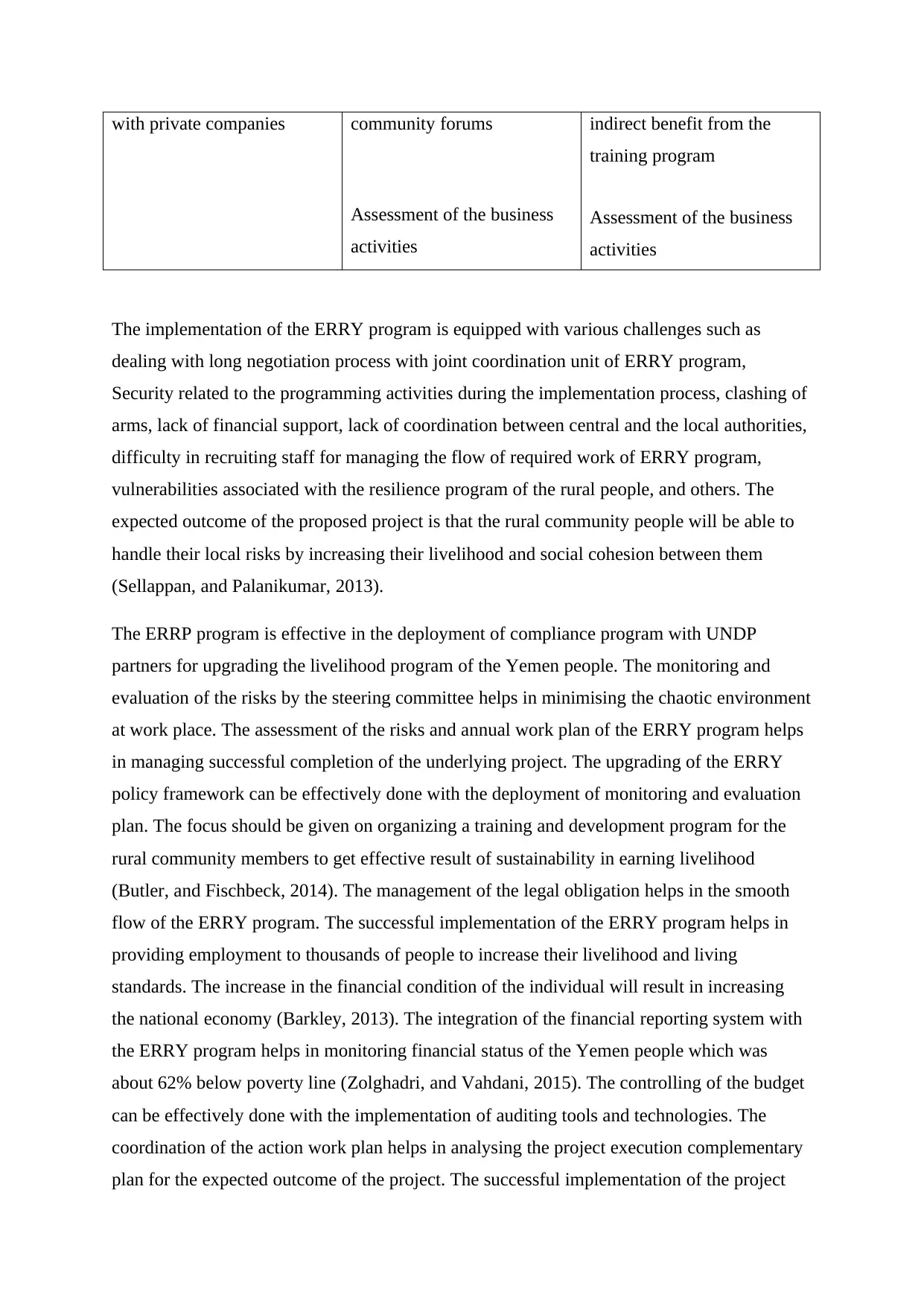
with private companies community forums
Assessment of the business
activities
indirect benefit from the
training program
Assessment of the business
activities
The implementation of the ERRY program is equipped with various challenges such as
dealing with long negotiation process with joint coordination unit of ERRY program,
Security related to the programming activities during the implementation process, clashing of
arms, lack of financial support, lack of coordination between central and the local authorities,
difficulty in recruiting staff for managing the flow of required work of ERRY program,
vulnerabilities associated with the resilience program of the rural people, and others. The
expected outcome of the proposed project is that the rural community people will be able to
handle their local risks by increasing their livelihood and social cohesion between them
(Sellappan, and Palanikumar, 2013).
The ERRP program is effective in the deployment of compliance program with UNDP
partners for upgrading the livelihood program of the Yemen people. The monitoring and
evaluation of the risks by the steering committee helps in minimising the chaotic environment
at work place. The assessment of the risks and annual work plan of the ERRY program helps
in managing successful completion of the underlying project. The upgrading of the ERRY
policy framework can be effectively done with the deployment of monitoring and evaluation
plan. The focus should be given on organizing a training and development program for the
rural community members to get effective result of sustainability in earning livelihood
(Butler, and Fischbeck, 2014). The management of the legal obligation helps in the smooth
flow of the ERRY program. The successful implementation of the ERRY program helps in
providing employment to thousands of people to increase their livelihood and living
standards. The increase in the financial condition of the individual will result in increasing
the national economy (Barkley, 2013). The integration of the financial reporting system with
the ERRY program helps in monitoring financial status of the Yemen people which was
about 62% below poverty line (Zolghadri, and Vahdani, 2015). The controlling of the budget
can be effectively done with the implementation of auditing tools and technologies. The
coordination of the action work plan helps in analysing the project execution complementary
plan for the expected outcome of the project. The successful implementation of the project
Assessment of the business
activities
indirect benefit from the
training program
Assessment of the business
activities
The implementation of the ERRY program is equipped with various challenges such as
dealing with long negotiation process with joint coordination unit of ERRY program,
Security related to the programming activities during the implementation process, clashing of
arms, lack of financial support, lack of coordination between central and the local authorities,
difficulty in recruiting staff for managing the flow of required work of ERRY program,
vulnerabilities associated with the resilience program of the rural people, and others. The
expected outcome of the proposed project is that the rural community people will be able to
handle their local risks by increasing their livelihood and social cohesion between them
(Sellappan, and Palanikumar, 2013).
The ERRP program is effective in the deployment of compliance program with UNDP
partners for upgrading the livelihood program of the Yemen people. The monitoring and
evaluation of the risks by the steering committee helps in minimising the chaotic environment
at work place. The assessment of the risks and annual work plan of the ERRY program helps
in managing successful completion of the underlying project. The upgrading of the ERRY
policy framework can be effectively done with the deployment of monitoring and evaluation
plan. The focus should be given on organizing a training and development program for the
rural community members to get effective result of sustainability in earning livelihood
(Butler, and Fischbeck, 2014). The management of the legal obligation helps in the smooth
flow of the ERRY program. The successful implementation of the ERRY program helps in
providing employment to thousands of people to increase their livelihood and living
standards. The increase in the financial condition of the individual will result in increasing
the national economy (Barkley, 2013). The integration of the financial reporting system with
the ERRY program helps in monitoring financial status of the Yemen people which was
about 62% below poverty line (Zolghadri, and Vahdani, 2015). The controlling of the budget
can be effectively done with the implementation of auditing tools and technologies. The
coordination of the action work plan helps in analysing the project execution complementary
plan for the expected outcome of the project. The successful implementation of the project
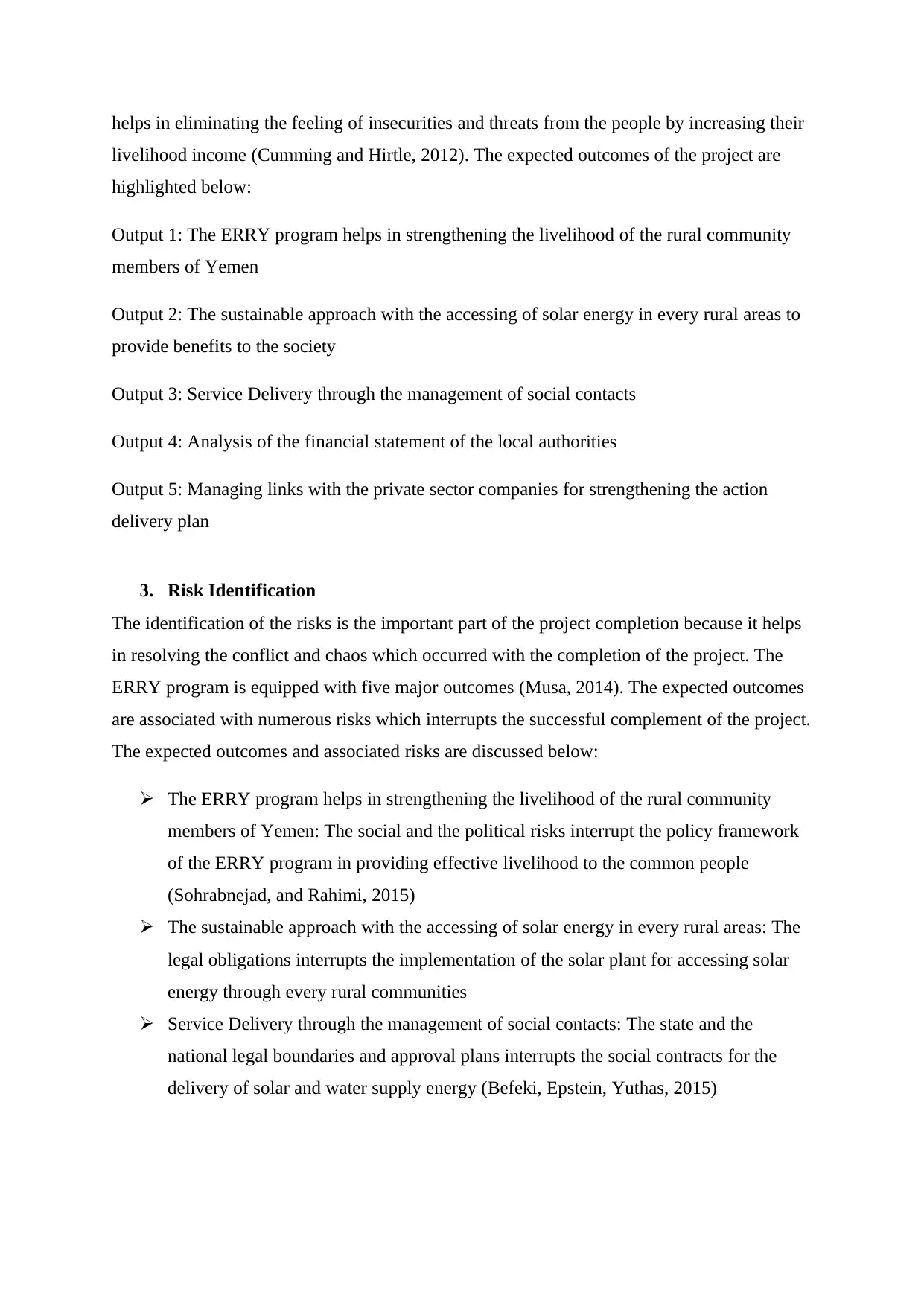
helps in eliminating the feeling of insecurities and threats from the people by increasing their
livelihood income (Cumming and Hirtle, 2012). The expected outcomes of the project are
highlighted below:
Output 1: The ERRY program helps in strengthening the livelihood of the rural community
members of Yemen
Output 2: The sustainable approach with the accessing of solar energy in every rural areas to
provide benefits to the society
Output 3: Service Delivery through the management of social contacts
Output 4: Analysis of the financial statement of the local authorities
Output 5: Managing links with the private sector companies for strengthening the action
delivery plan
3. Risk Identification
The identification of the risks is the important part of the project completion because it helps
in resolving the conflict and chaos which occurred with the completion of the project. The
ERRY program is equipped with five major outcomes (Musa, 2014). The expected outcomes
are associated with numerous risks which interrupts the successful complement of the project.
The expected outcomes and associated risks are discussed below:
The ERRY program helps in strengthening the livelihood of the rural community
members of Yemen: The social and the political risks interrupt the policy framework
of the ERRY program in providing effective livelihood to the common people
(Sohrabnejad, and Rahimi, 2015)
The sustainable approach with the accessing of solar energy in every rural areas: The
legal obligations interrupts the implementation of the solar plant for accessing solar
energy through every rural communities
Service Delivery through the management of social contacts: The state and the
national legal boundaries and approval plans interrupts the social contracts for the
delivery of solar and water supply energy (Befeki, Epstein, Yuthas, 2015)
livelihood income (Cumming and Hirtle, 2012). The expected outcomes of the project are
highlighted below:
Output 1: The ERRY program helps in strengthening the livelihood of the rural community
members of Yemen
Output 2: The sustainable approach with the accessing of solar energy in every rural areas to
provide benefits to the society
Output 3: Service Delivery through the management of social contacts
Output 4: Analysis of the financial statement of the local authorities
Output 5: Managing links with the private sector companies for strengthening the action
delivery plan
3. Risk Identification
The identification of the risks is the important part of the project completion because it helps
in resolving the conflict and chaos which occurred with the completion of the project. The
ERRY program is equipped with five major outcomes (Musa, 2014). The expected outcomes
are associated with numerous risks which interrupts the successful complement of the project.
The expected outcomes and associated risks are discussed below:
The ERRY program helps in strengthening the livelihood of the rural community
members of Yemen: The social and the political risks interrupt the policy framework
of the ERRY program in providing effective livelihood to the common people
(Sohrabnejad, and Rahimi, 2015)
The sustainable approach with the accessing of solar energy in every rural areas: The
legal obligations interrupts the implementation of the solar plant for accessing solar
energy through every rural communities
Service Delivery through the management of social contacts: The state and the
national legal boundaries and approval plans interrupts the social contracts for the
delivery of solar and water supply energy (Befeki, Epstein, Yuthas, 2015)
⊘ This is a preview!⊘
Do you want full access?
Subscribe today to unlock all pages.

Trusted by 1+ million students worldwide
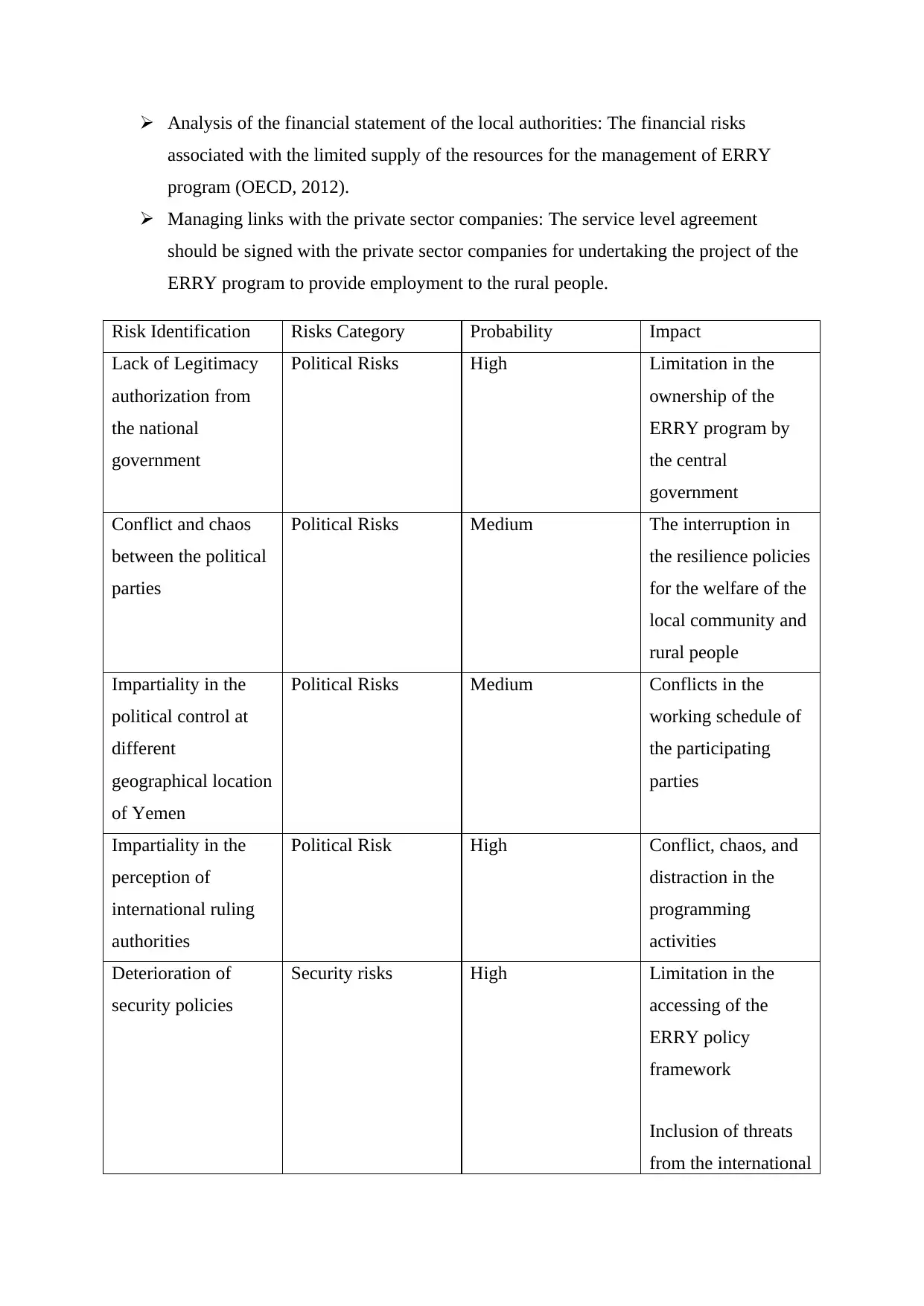
Analysis of the financial statement of the local authorities: The financial risks
associated with the limited supply of the resources for the management of ERRY
program (OECD, 2012).
Managing links with the private sector companies: The service level agreement
should be signed with the private sector companies for undertaking the project of the
ERRY program to provide employment to the rural people.
Risk Identification Risks Category Probability Impact
Lack of Legitimacy
authorization from
the national
government
Political Risks High Limitation in the
ownership of the
ERRY program by
the central
government
Conflict and chaos
between the political
parties
Political Risks Medium The interruption in
the resilience policies
for the welfare of the
local community and
rural people
Impartiality in the
political control at
different
geographical location
of Yemen
Political Risks Medium Conflicts in the
working schedule of
the participating
parties
Impartiality in the
perception of
international ruling
authorities
Political Risk High Conflict, chaos, and
distraction in the
programming
activities
Deterioration of
security policies
Security risks High Limitation in the
accessing of the
ERRY policy
framework
Inclusion of threats
from the international
associated with the limited supply of the resources for the management of ERRY
program (OECD, 2012).
Managing links with the private sector companies: The service level agreement
should be signed with the private sector companies for undertaking the project of the
ERRY program to provide employment to the rural people.
Risk Identification Risks Category Probability Impact
Lack of Legitimacy
authorization from
the national
government
Political Risks High Limitation in the
ownership of the
ERRY program by
the central
government
Conflict and chaos
between the political
parties
Political Risks Medium The interruption in
the resilience policies
for the welfare of the
local community and
rural people
Impartiality in the
political control at
different
geographical location
of Yemen
Political Risks Medium Conflicts in the
working schedule of
the participating
parties
Impartiality in the
perception of
international ruling
authorities
Political Risk High Conflict, chaos, and
distraction in the
programming
activities
Deterioration of
security policies
Security risks High Limitation in the
accessing of the
ERRY policy
framework
Inclusion of threats
from the international
Paraphrase This Document
Need a fresh take? Get an instant paraphrase of this document with our AI Paraphraser
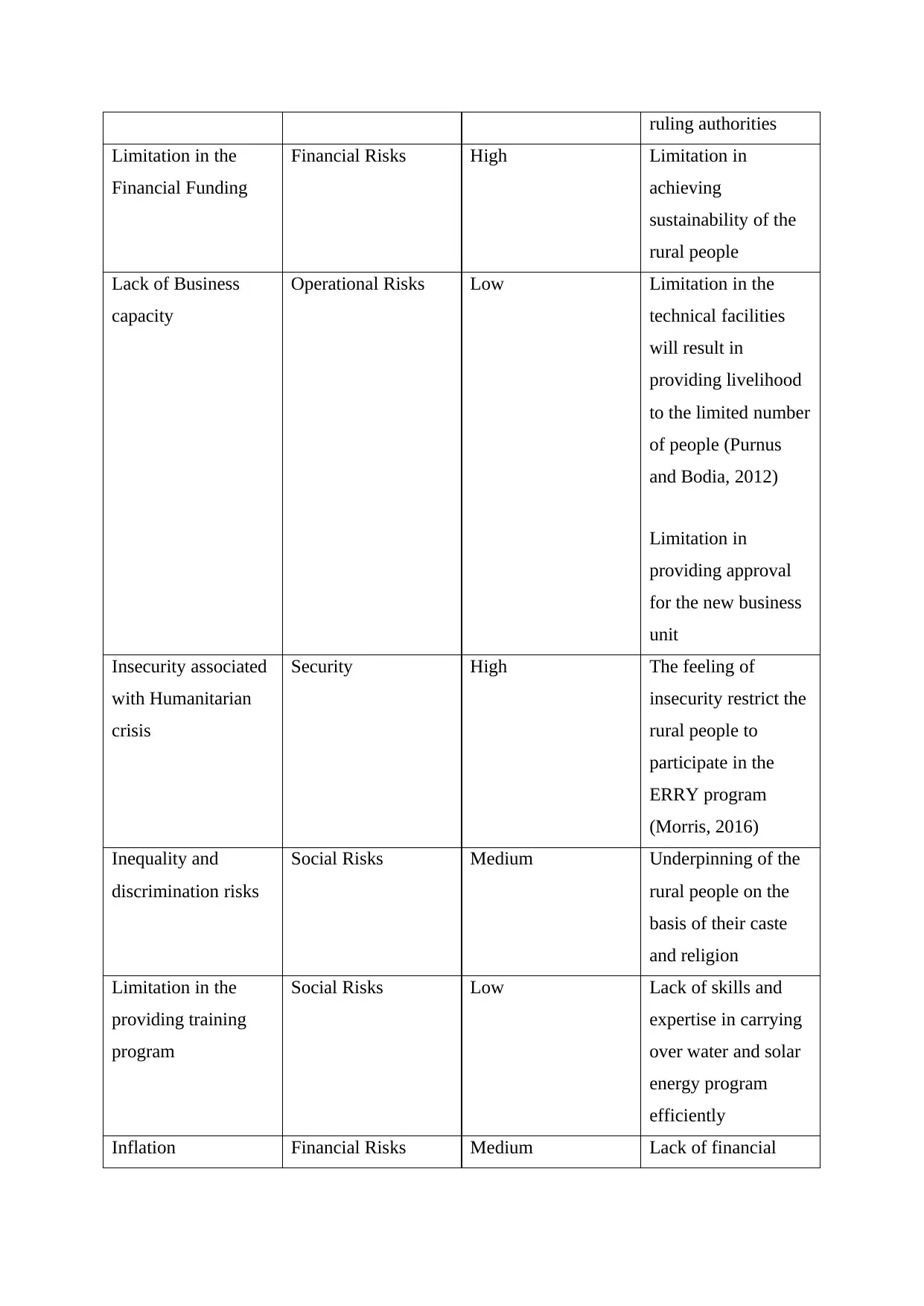
ruling authorities
Limitation in the
Financial Funding
Financial Risks High Limitation in
achieving
sustainability of the
rural people
Lack of Business
capacity
Operational Risks Low Limitation in the
technical facilities
will result in
providing livelihood
to the limited number
of people (Purnus
and Bodia, 2012)
Limitation in
providing approval
for the new business
unit
Insecurity associated
with Humanitarian
crisis
Security High The feeling of
insecurity restrict the
rural people to
participate in the
ERRY program
(Morris, 2016)
Inequality and
discrimination risks
Social Risks Medium Underpinning of the
rural people on the
basis of their caste
and religion
Limitation in the
providing training
program
Social Risks Low Lack of skills and
expertise in carrying
over water and solar
energy program
efficiently
Inflation Financial Risks Medium Lack of financial
Limitation in the
Financial Funding
Financial Risks High Limitation in
achieving
sustainability of the
rural people
Lack of Business
capacity
Operational Risks Low Limitation in the
technical facilities
will result in
providing livelihood
to the limited number
of people (Purnus
and Bodia, 2012)
Limitation in
providing approval
for the new business
unit
Insecurity associated
with Humanitarian
crisis
Security High The feeling of
insecurity restrict the
rural people to
participate in the
ERRY program
(Morris, 2016)
Inequality and
discrimination risks
Social Risks Medium Underpinning of the
rural people on the
basis of their caste
and religion
Limitation in the
providing training
program
Social Risks Low Lack of skills and
expertise in carrying
over water and solar
energy program
efficiently
Inflation Financial Risks Medium Lack of financial
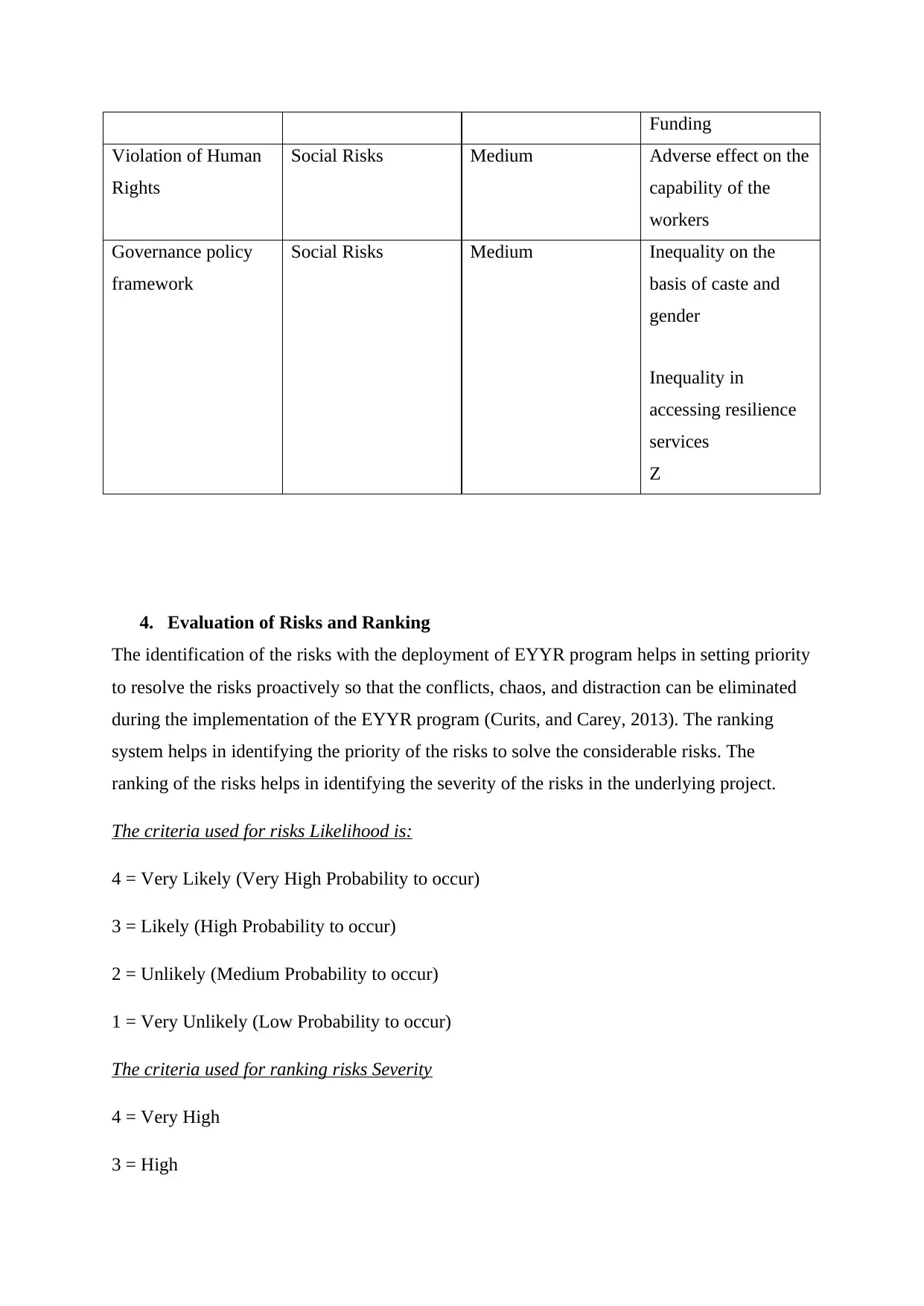
Funding
Violation of Human
Rights
Social Risks Medium Adverse effect on the
capability of the
workers
Governance policy
framework
Social Risks Medium Inequality on the
basis of caste and
gender
Inequality in
accessing resilience
services
Z
4. Evaluation of Risks and Ranking
The identification of the risks with the deployment of EYYR program helps in setting priority
to resolve the risks proactively so that the conflicts, chaos, and distraction can be eliminated
during the implementation of the EYYR program (Curits, and Carey, 2013). The ranking
system helps in identifying the priority of the risks to solve the considerable risks. The
ranking of the risks helps in identifying the severity of the risks in the underlying project.
The criteria used for risks Likelihood is:
4 = Very Likely (Very High Probability to occur)
3 = Likely (High Probability to occur)
2 = Unlikely (Medium Probability to occur)
1 = Very Unlikely (Low Probability to occur)
The criteria used for ranking risks Severity
4 = Very High
3 = High
Violation of Human
Rights
Social Risks Medium Adverse effect on the
capability of the
workers
Governance policy
framework
Social Risks Medium Inequality on the
basis of caste and
gender
Inequality in
accessing resilience
services
Z
4. Evaluation of Risks and Ranking
The identification of the risks with the deployment of EYYR program helps in setting priority
to resolve the risks proactively so that the conflicts, chaos, and distraction can be eliminated
during the implementation of the EYYR program (Curits, and Carey, 2013). The ranking
system helps in identifying the priority of the risks to solve the considerable risks. The
ranking of the risks helps in identifying the severity of the risks in the underlying project.
The criteria used for risks Likelihood is:
4 = Very Likely (Very High Probability to occur)
3 = Likely (High Probability to occur)
2 = Unlikely (Medium Probability to occur)
1 = Very Unlikely (Low Probability to occur)
The criteria used for ranking risks Severity
4 = Very High
3 = High
⊘ This is a preview!⊘
Do you want full access?
Subscribe today to unlock all pages.

Trusted by 1+ million students worldwide
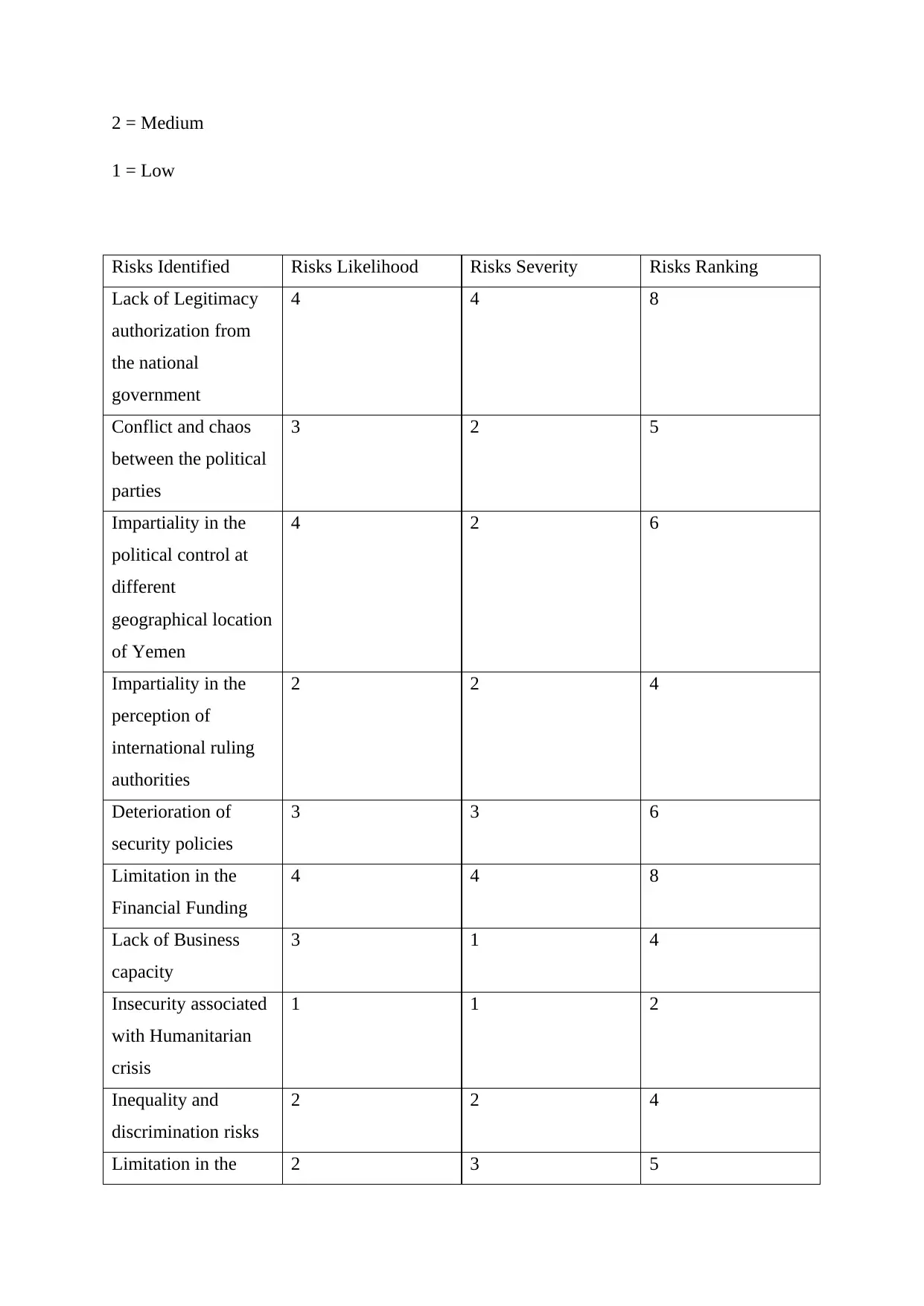
2 = Medium
1 = Low
Risks Identified Risks Likelihood Risks Severity Risks Ranking
Lack of Legitimacy
authorization from
the national
government
4 4 8
Conflict and chaos
between the political
parties
3 2 5
Impartiality in the
political control at
different
geographical location
of Yemen
4 2 6
Impartiality in the
perception of
international ruling
authorities
2 2 4
Deterioration of
security policies
3 3 6
Limitation in the
Financial Funding
4 4 8
Lack of Business
capacity
3 1 4
Insecurity associated
with Humanitarian
crisis
1 1 2
Inequality and
discrimination risks
2 2 4
Limitation in the 2 3 5
1 = Low
Risks Identified Risks Likelihood Risks Severity Risks Ranking
Lack of Legitimacy
authorization from
the national
government
4 4 8
Conflict and chaos
between the political
parties
3 2 5
Impartiality in the
political control at
different
geographical location
of Yemen
4 2 6
Impartiality in the
perception of
international ruling
authorities
2 2 4
Deterioration of
security policies
3 3 6
Limitation in the
Financial Funding
4 4 8
Lack of Business
capacity
3 1 4
Insecurity associated
with Humanitarian
crisis
1 1 2
Inequality and
discrimination risks
2 2 4
Limitation in the 2 3 5
Paraphrase This Document
Need a fresh take? Get an instant paraphrase of this document with our AI Paraphraser
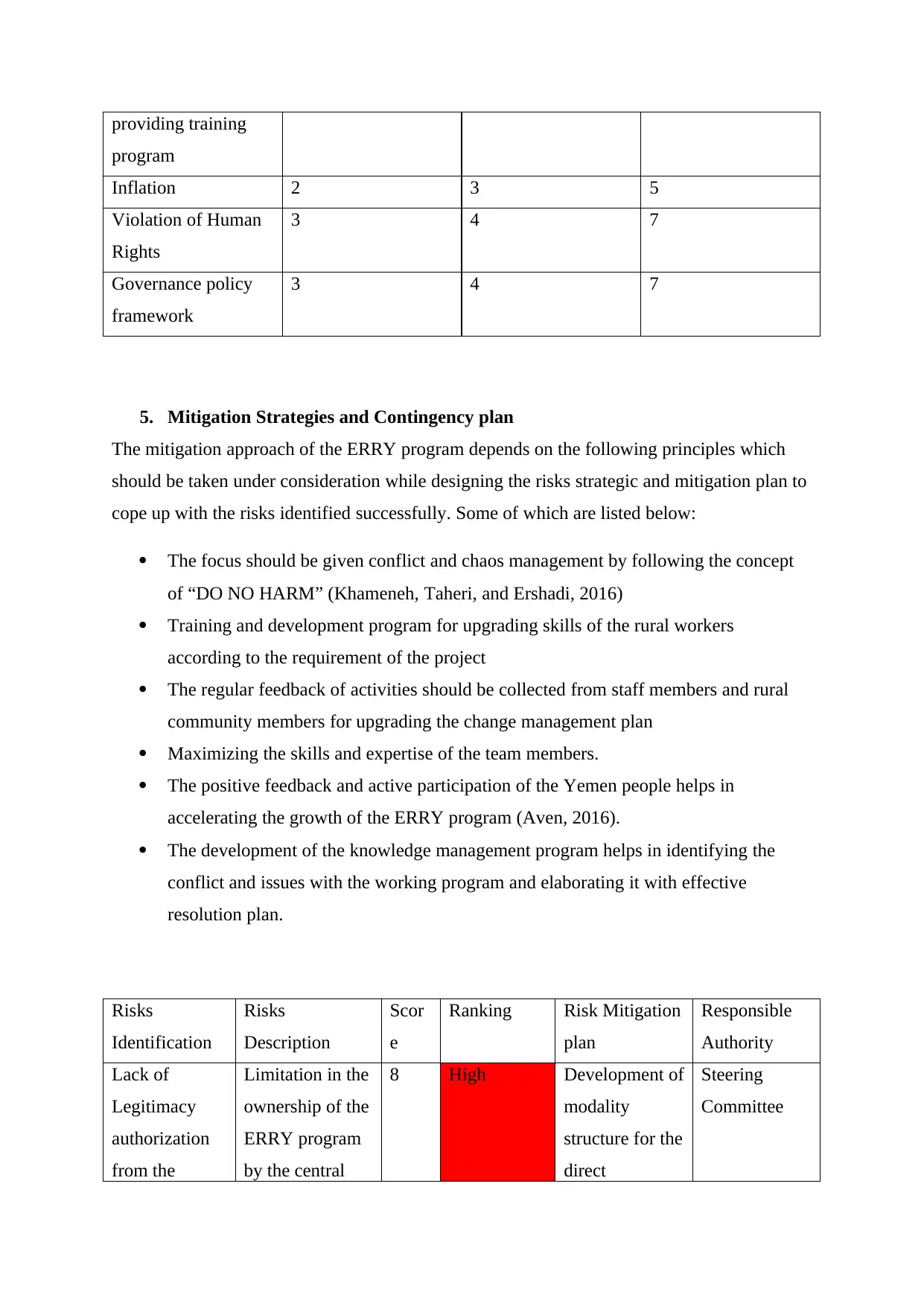
providing training
program
Inflation 2 3 5
Violation of Human
Rights
3 4 7
Governance policy
framework
3 4 7
5. Mitigation Strategies and Contingency plan
The mitigation approach of the ERRY program depends on the following principles which
should be taken under consideration while designing the risks strategic and mitigation plan to
cope up with the risks identified successfully. Some of which are listed below:
The focus should be given conflict and chaos management by following the concept
of “DO NO HARM” (Khameneh, Taheri, and Ershadi, 2016)
Training and development program for upgrading skills of the rural workers
according to the requirement of the project
The regular feedback of activities should be collected from staff members and rural
community members for upgrading the change management plan
Maximizing the skills and expertise of the team members.
The positive feedback and active participation of the Yemen people helps in
accelerating the growth of the ERRY program (Aven, 2016).
The development of the knowledge management program helps in identifying the
conflict and issues with the working program and elaborating it with effective
resolution plan.
Risks
Identification
Risks
Description
Scor
e
Ranking Risk Mitigation
plan
Responsible
Authority
Lack of
Legitimacy
authorization
from the
Limitation in the
ownership of the
ERRY program
by the central
8 High Development of
modality
structure for the
direct
Steering
Committee
program
Inflation 2 3 5
Violation of Human
Rights
3 4 7
Governance policy
framework
3 4 7
5. Mitigation Strategies and Contingency plan
The mitigation approach of the ERRY program depends on the following principles which
should be taken under consideration while designing the risks strategic and mitigation plan to
cope up with the risks identified successfully. Some of which are listed below:
The focus should be given conflict and chaos management by following the concept
of “DO NO HARM” (Khameneh, Taheri, and Ershadi, 2016)
Training and development program for upgrading skills of the rural workers
according to the requirement of the project
The regular feedback of activities should be collected from staff members and rural
community members for upgrading the change management plan
Maximizing the skills and expertise of the team members.
The positive feedback and active participation of the Yemen people helps in
accelerating the growth of the ERRY program (Aven, 2016).
The development of the knowledge management program helps in identifying the
conflict and issues with the working program and elaborating it with effective
resolution plan.
Risks
Identification
Risks
Description
Scor
e
Ranking Risk Mitigation
plan
Responsible
Authority
Lack of
Legitimacy
authorization
from the
Limitation in the
ownership of the
ERRY program
by the central
8 High Development of
modality
structure for the
direct
Steering
Committee
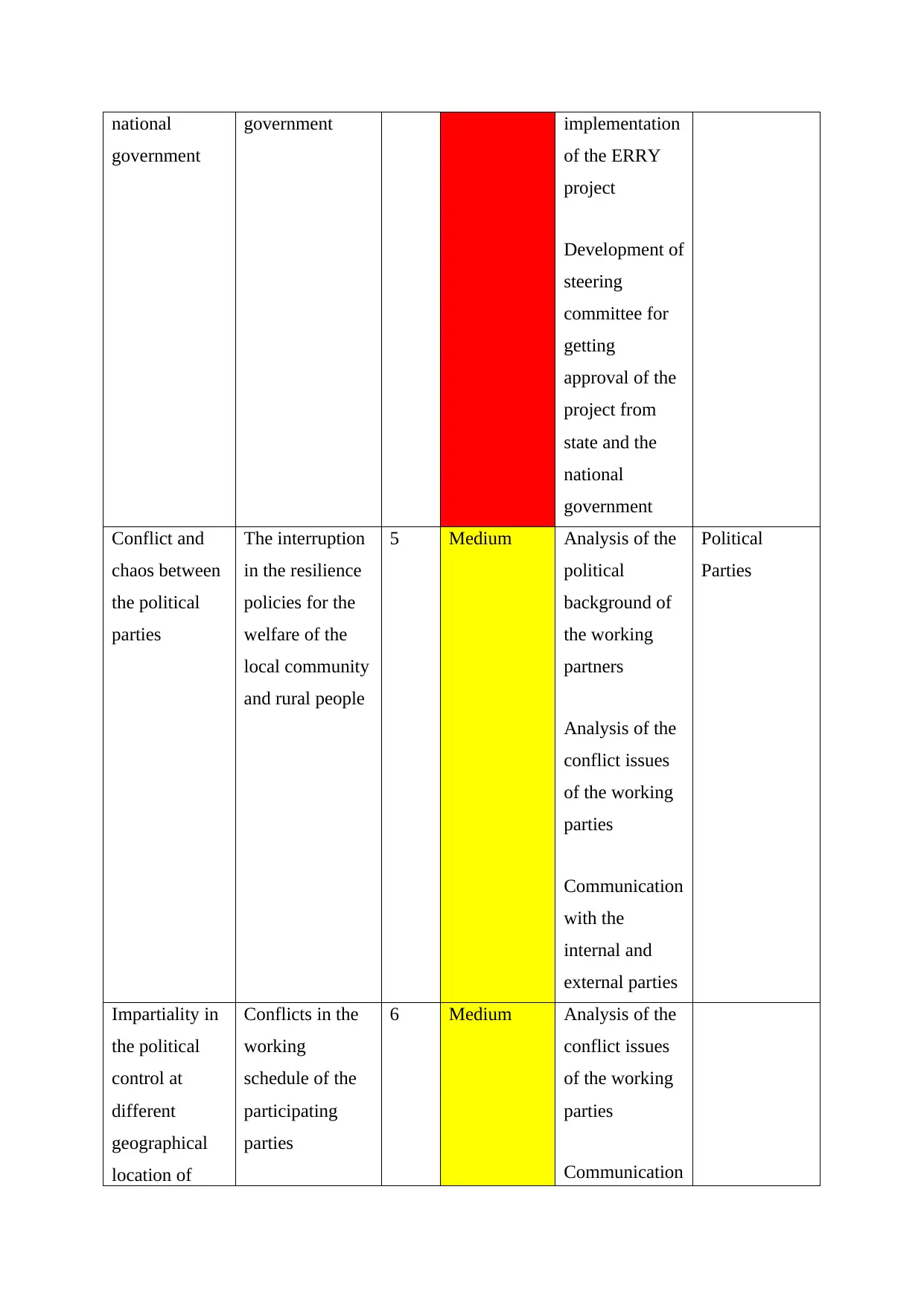
national
government
government implementation
of the ERRY
project
Development of
steering
committee for
getting
approval of the
project from
state and the
national
government
Conflict and
chaos between
the political
parties
The interruption
in the resilience
policies for the
welfare of the
local community
and rural people
5 Medium Analysis of the
political
background of
the working
partners
Analysis of the
conflict issues
of the working
parties
Communication
with the
internal and
external parties
Political
Parties
Impartiality in
the political
control at
different
geographical
location of
Conflicts in the
working
schedule of the
participating
parties
6 Medium Analysis of the
conflict issues
of the working
parties
Communication
government
government implementation
of the ERRY
project
Development of
steering
committee for
getting
approval of the
project from
state and the
national
government
Conflict and
chaos between
the political
parties
The interruption
in the resilience
policies for the
welfare of the
local community
and rural people
5 Medium Analysis of the
political
background of
the working
partners
Analysis of the
conflict issues
of the working
parties
Communication
with the
internal and
external parties
Political
Parties
Impartiality in
the political
control at
different
geographical
location of
Conflicts in the
working
schedule of the
participating
parties
6 Medium Analysis of the
conflict issues
of the working
parties
Communication
⊘ This is a preview!⊘
Do you want full access?
Subscribe today to unlock all pages.

Trusted by 1+ million students worldwide
1 out of 24
Your All-in-One AI-Powered Toolkit for Academic Success.
+13062052269
info@desklib.com
Available 24*7 on WhatsApp / Email
![[object Object]](/_next/static/media/star-bottom.7253800d.svg)
Unlock your academic potential
Copyright © 2020–2025 A2Z Services. All Rights Reserved. Developed and managed by ZUCOL.
